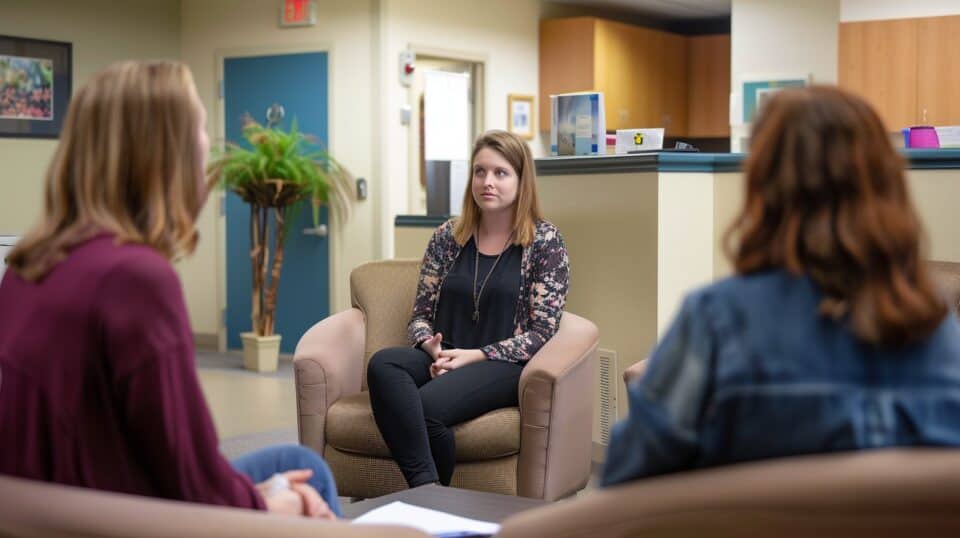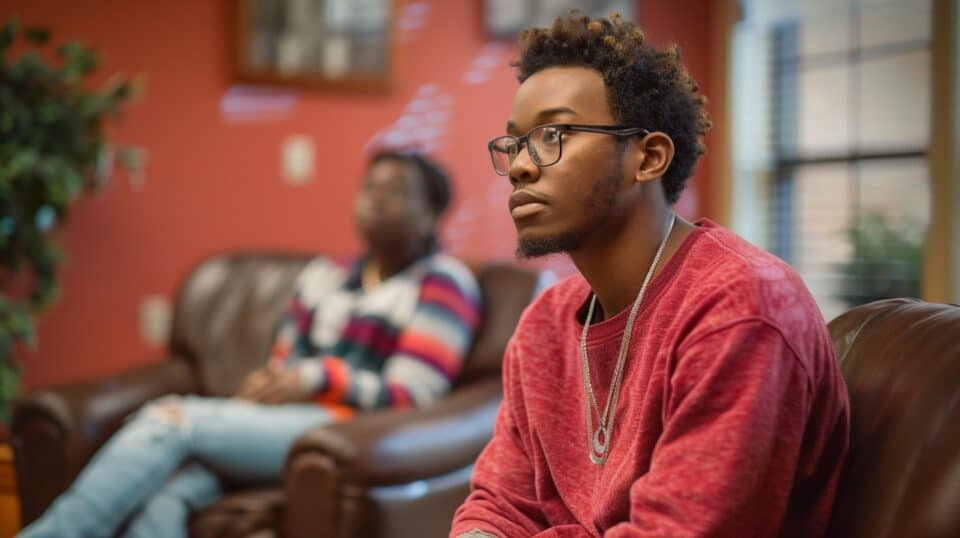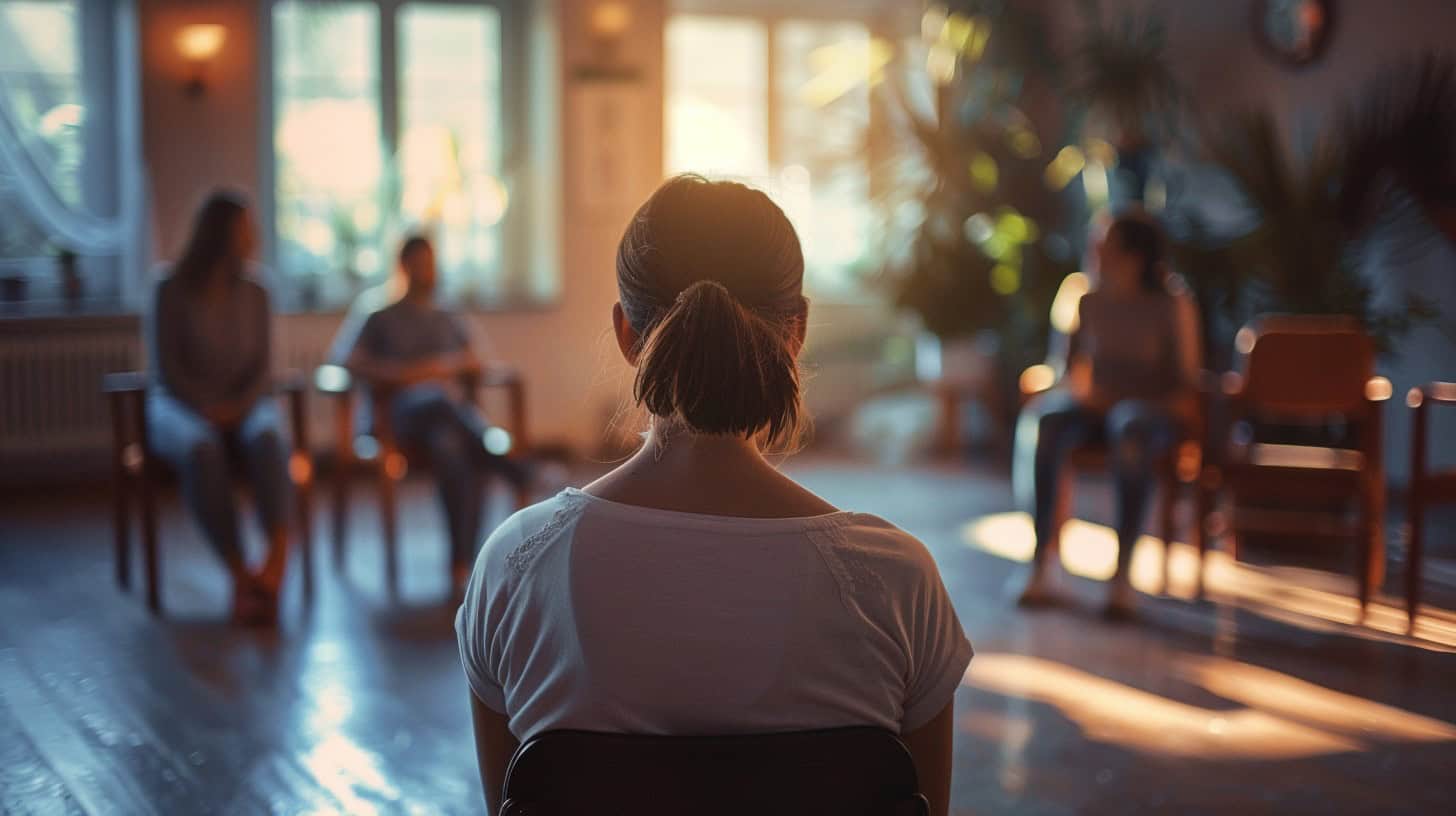Intensive Outpatient Programs (IOP) offer a flexible path to recovery. These programs last 2 weeks to 3 months, based on individual needs. 1 IOPs provide structured support without full-time commitment.
Clients attend therapy sessions, counseling, and life skills classes while maintaining daily routines.
As a certified addiction specialist with 10 years of experience, I’ve seen IOPs transform lives. These programs blend professional care with personal freedom. They equip individuals with tools to manage addiction and mental health challenges. 3 If you’re interested in learning more about IOP benefits, let’s explore them together.
Key Takeaways
IOP programs typically last 2 weeks to 3 months, with clients attending 9-10 hours of therapy per week spread across 3-5 days.
IOPs are more flexible than inpatient care, allowing patients to maintain work and family responsibilities while receiving treatment.
Factors affecting IOP length include severity of substance use, co-occurring disorders, progress in treatment, support system, and insurance coverage.
IOPs cost 40-60% less than residential programs and offer a balance between intensive care and independent living.
Successful IOP completion involves achieving symptom management, developing coping skills, and creating a solid aftercare plan for ongoing support.
Table of Contents
Exploring Intensive Outpatient Programs

Intensive Outpatient Programs (IOPs) offer a structured approach to addiction treatment. They blend therapy and support while allowing patients to maintain daily routines.
Definition and Purpose of IOP
Intensive Outpatient Programs (IOPs) offer structured treatment for substance use disorders and co-occurring mental health issues. These programs provide a middle ground between inpatient care and traditional outpatient therapy, requiring at least 10 hours of weekly meetings. 1 IOP programs allow clients to maintain daily routines while receiving comprehensive support. They focus on trauma education, vocational skills, emotional regulation, and relapse prevention.
IOPs serve a crucial purpose in addiction recovery. They equip participants with coping strategies and life skills needed for long-term sobriety. The flexibility of IOP programs enables women to balance treatment with work, family, and other responsibilities.
This approach fosters independence and community integration, essential components for sustained recovery. IOPs typically last 2 weeks to 3 months, tailoring treatment duration to individual needs and progress. 2
Essential Elements of IOPs
Intensive Outpatient Programs (IOPs) offer a structured environment with consistent treatment. Clients engage in 9 hours of therapy per week, focusing on group sessions, individual counseling, and life skills classes. 3 The core elements include trauma education, vocational training, emotional regulation, and relapse prevention strategies. These programs provide a balance between intensive care and maintaining daily routines.
IOPs require a safe home environment free from substances and violence. 4 Courses cover essential topics like community support and coping mechanisms. For adolescents, the program typically involves 6 hours of weekly therapy. 3 The next section will explore the duration of these flexible recovery programs.
IOPs are the bridge between intensive care and everyday life, offering structured support while allowing clients to maintain their responsibilities.
Duration of Intensive Outpatient Programs

IOPs vary in length, often lasting 8-12 weeks. Treatment duration depends on individual needs, progress, and insurance coverage.
Standard Length of IOP Sessions
IOP sessions typically run 2 to 5 hours per day, 3 to 5 days a week. Most programs require a minimum of 9 hours of treatment weekly, often split into three 3-hour blocks. 2 This flexible schedule allows women to balance recovery with work, family, and other responsibilities.
Some centers, like Insight Recovery, offer programs without a set length, tailoring treatment duration to individual needs and progress. 5
The standard IOP length ranges from 2 weeks to 3 months. 5 This timeframe provides ample opportunity for participants to develop coping skills, address underlying issues, and build a strong foundation for long-term sobriety.
Group therapy, individual counseling, and medication management often form the core components of these intensive sessions, targeting both substance use and co-occurring mental health disorders.
Factors That Affect Program Length
The duration of Intensive Outpatient Programs (IOPs) varies based on individual needs and circumstances. Several key factors influence the length of an IOP:
- Severity of substance use: More severe cases often require longer treatment periods.
- Co-occurring disorders: Dual diagnoses, like depression or anxiety alongside addiction, may extend program length.
- Progress in treatment: Faster progress can lead to shorter programs, while slower improvement might necessitate extended care. 7
- Support system: Strong family and community support can reduce program duration.
- Previous treatment history: Those with prior treatment experiences might need shorter or longer programs, depending on outcomes.
- Type of substance used: Different drugs may require varying treatment lengths due to their specific effects and withdrawal processes.
- Personal goals: Individual recovery objectives can impact program duration.
- Work and family commitments: Balancing treatment with life responsibilities may affect program length.
- Insurance coverage: Available insurance benefits can influence the duration of care.
- Legal requirements: Court-mandated treatment might have specific length requirements.
- Physical health: Concurrent medical issues may extend treatment duration.
- Age: Younger individuals or those with an alcoholic parent might need longer programs for sustainable recovery.
- Motivation level: Higher motivation can lead to faster progress and potentially shorter program lengths. 6
Comparing IOP with Other Treatment Options

IOP offers more flexibility than inpatient care, letting you stay at home. It’s less intense than PHP, with fewer weekly sessions – perfect for those needing support while managing daily life.
IOP versus Inpatient Treatment
Inpatient treatment and Intensive Outpatient Programs (IOP) offer distinct approaches to recovery. Inpatient care provides 24/7 monitoring in a structured environment, ideal for detox, severe mental health issues, or those lacking a supportive home setting.
It involves overnight stays and round-the-clock medical attention. IOP, on the other hand, allows more freedom with part-time sessions. Clients return home after treatment, making it suitable for those unable to take leave from work or school. 8
IOP bridges the gap between intensive inpatient care and independent living.
IOP helps build a support system post-inpatient stay. It offers flexibility while maintaining therapeutic benefits. Women often find IOP’s balance of treatment and daily life responsibilities appealing.
The choice between inpatient and IOP depends on individual needs, severity of condition, and personal circumstances. 4
IOP versus PHP (Partial Hospitalization Programs)
IOP and PHP offer different levels of care for women seeking recovery. PHP provides a higher intensity of treatment, lasting 2 to 4 weeks with 5 to 7 days of therapy per week, 6 to 8 hours daily.
IOP, a step down from PHP, requires a minimum of 9 hours of service weekly, typically spread across 3 days for 3 hours each session. 4 Both programs use cognitive behavioral therapy and group therapy, but PHP offers more structured support for those needing closer monitoring.
Choosing between IOP and PHP depends on individual needs and circumstances. PHP suits women requiring more intensive care but unable to commit to full inpatient treatment. IOP allows greater flexibility, ideal for those balancing recovery with work or family responsibilities. 9 The next section explores the advantages of IOP in detail.
Advantages of IOP

IOPs offer a path to recovery that fits into your daily life. They provide expert care while letting you stay connected to your support network and responsibilities.
Flexibility and Access
Intensive outpatient programs offer unparalleled flexibility for women juggling multiple responsibilities. Clients can maintain their daily routines while receiving treatment, typically committing to about 10 hours per week. 10 This schedule allows for work, school, or family obligations. Evening and weekend sessions cater to diverse needs, ensuring access to care without disrupting life’s demands. 11
IOPs provide a unique blend of structure and freedom. Participants gain real-world skills during treatment hours and apply them immediately in their daily lives. This immediate application reinforces learning and promotes lasting change.
The program’s design also supports privacy, letting clients build a sober community without sacrificing their personal or professional lives.
IOPs offer the best of both worlds: intensive treatment and real-life integration.
Economic Benefits
IOPs offer significant cost savings compared to inpatient care. Patients can continue working or attending school while receiving treatment, maintaining their income and stability. 12 This flexibility reduces financial strain on families and individuals seeking recovery. IOPs typically cost 40-60% less than residential programs, making them a budget-friendly option for many women. 4
The economic advantages extend beyond immediate savings. By allowing patients to practice new skills in real-world settings, IOPs promote lasting change and reduce the likelihood of costly relapses.
Women can maintain their roles as caregivers, professionals, or students while addressing their health needs. This balance supports long-term financial stability and career growth.
Support within the Community
Community support plays a crucial role in recovery. Women in IOPs benefit from peer connections and group activities. 4 These interactions reduce isolation and foster a sense of belonging.
Local resources provide practical help, while encouragement from others boosts motivation. Shared experiences create understanding, strengthening the recovery journey. 6 Peer support groups offer a safe space to discuss challenges and celebrate successes.
Access to community resources enhances treatment outcomes. Women can tap into job training, housing assistance, and childcare services. These supports address real-life needs, making it easier to focus on recovery.
Involvement in community activities builds new, healthy social networks. This social integration helps women rebuild their lives beyond addiction. 6
Criteria for Successful Completion of IOP

Completing an IOP isn’t just about showing up. It’s about reaching goals and gaining tools for lasting recovery. Progress in symptom management and a solid aftercare plan are key markers of success.
Evaluating Progress
Progress evaluation in IOP hinges on key factors. Clients work with therapists to assess symptom management, relapse prevention skills, and overall stability. Regular check-ins track improvements in mood, behavior, and coping strategies.
Therapists use standardized assessments to measure progress objectively. Goals set at program start serve as benchmarks. Positive changes in relationships, work, and daily functioning indicate success.
Client feedback plays a crucial role in gauging treatment effectiveness.
Retention rates and abstinence from substances are vital metrics. Early identification of relapse triggers allows for timely interventions. 13 Therapists monitor client readiness for change throughout the program.
Addressing disruptive behaviors in group settings is essential for overall progress. Ethical considerations and confidentiality remain paramount in evaluating and discussing client advancement.
Some IOPs may last 90 days or more, although the ASAM Criteria does not specify a minimum duration for IOPs. 14
Achieving Symptom Management
Intensive Outpatient Programs (IOPs) focus on achieving symptom management through comprehensive support. Group therapy sessions help women develop coping strategies for substance use disorders and mental health issues.
Medication management, a key component, addresses withdrawal symptoms and cravings. IOPs offer individual, couples, and family counseling to tackle the root causes of addiction. This customized approach enables patients to manage their symptoms while maintaining daily routines. 15
Women in IOPs learn practical skills for distress tolerance and emotional regulation. The program emphasizes self-care techniques, including meditation and relaxation exercises. Participants practice social skills in a supportive environment, preparing for real-world challenges.
IOPs typically run 3-5 days a week for several hours each day, allowing flexibility for work or family commitments. This structure supports a gradual return to daily activities while providing ongoing care. 4
Planning for Ongoing Care
Achieving symptom management paves the way for long-term recovery planning. Ongoing care after IOP involves connecting patients to support networks and addressing practical recovery issues. 4 Patients work with therapists to develop personalized aftercare plans, identifying potential triggers and coping strategies. These plans often include regular check-ins, support group attendance, and continued therapy sessions.
Employment assistance and housing support may also be incorporated to ensure a stable foundation for sustained sobriety.
Successful ongoing care requires active patient engagement and a commitment to abstinence. 16 Therapists help patients set realistic goals and develop self-efficacy skills to manage cravings and prevent relapse.
Family involvement plays a crucial role, with education on supporting their loved one’s recovery journey. Continuing care programs typically last 3-6 months, gradually decreasing in intensity as patients gain confidence in their recovery skills.
Continuing Care Post-IOP

After IOP, patients often need ongoing support… Want to know more about post-IOP care options? Keep reading!
Continuation Options for Support
Continuing care after IOP is crucial for maintaining recovery progress. Women have several options to sustain their sobriety and mental well-being post-treatment.
- Assertive Continuing Care (ACC): This 12-month program offers personalized support for adolescents, helping them maintain abstinence and build on initial treatment gains. 16
- Telephone-based Support: Regular check-ins via phone provide ongoing guidance and accountability, fitting easily into busy schedules.
- Mobile Health Interventions: Automated apps and text services offer 24/7 access to coping strategies and motivation, supporting women through challenging moments.
- Sober Living Homes: These group residences provide a structured, substance-free environment, easing the transition back to independent living.
- Outpatient Therapy: Individual or group sessions with a therapist help address ongoing mental health concerns and prevent relapse.
- Support Groups: Organizations like Alcoholics Anonymous and Narcotics Anonymous offer peer support and a sense of community.
- Holistic Wellness Programs: Yoga, meditation, and nutrition classes promote overall health and stress management skills.
- Vocational Training: Programs that focus on job skills and career development support financial independence and self-esteem.
These continuation options cater to various needs, ensuring women have access to flexible, long-term support. The next section explores the criteria for successful completion of IOP. 4
The Role of Community and Family
[Do not include this line in the output]
Support from family and community plays a crucial role in recovery. Loved ones provide emotional backing, encouragement, and practical help during treatment. Community resources like support groups offer ongoing connection with others facing similar challenges.
Family therapy sessions often complement IOP treatment, improving communication and addressing relationship issues that may contribute to substance use. Engaging family members in the recovery process increases the chances of long-term success by creating a supportive home environment.
Local community organizations frequently partner with IOP programs to offer additional services. These may include job training, housing assistance, or recreational activities that promote a healthy lifestyle.
Connecting patients to these resources helps build a strong foundation for sustained recovery after completing the intensive phase of treatment. Involvement in community activities also reduces isolation and provides positive social connections – key factors in maintaining sobriety.
People Also Ask
What’s an IOP program?
An Intensive Outpatient Program (IOP) is a flexible treatment option for substance abuse and mental health issues. It’s less intense than residential treatment, but more structured than regular outpatient care.
How long do IOP programs typically last?
IOP programs vary in length. Most run 8-12 weeks, but some can be shorter or longer. The duration depends on individual needs and progress in recovery.
Can I work while in an IOP?
Yes. IOPs are designed to fit around work or school schedules. Sessions often occur in the evenings or on weekends, allowing patients to maintain daily responsibilities.
What therapies are used in IOPs?
IOPs use various therapies. These may include Dialectical Behavioral Therapy (DBT), group therapy, and individual counseling. Some programs offer medication-assisted treatment for opioid use disorders.
How does an IOP differ from a Partial Hospitalization Program (PHP)?
IOPs are less intensive than PHPs. PHPs require more hours per week and offer more medical support. IOPs focus on therapy and skills training, with less emphasis on medical care.
Are IOPs effective for dual diagnosis?
Yes. Many IOPs specialize in treating co-occurring disorders. They address both mental health and substance abuse issues simultaneously, using a holistic approach to recovery.
References
^ https://www.sandstonecare.com/blog/17-questions-intensive-outpatient-programs/ (2024-02-13)
^ https://americanaddictioncenters.org/intensive-outpatient-programs
^ https://www.forbes.com/health/mind/intensive-outpatient-program/
^ https://www.ncbi.nlm.nih.gov/pmc/articles/PMC4152944/
^ https://www.insightrecoverycenters.com/rehab-blog/rehab-blog-how-long-does-iop-last/ (2023-02-28)
^ https://www.ncbi.nlm.nih.gov/books/NBK64087/
^ https://www.ncbi.nlm.nih.gov/books/NBK64088/
^ https://releaserecovery.com/iop-vs-inpatient-treatment-in-2024-choosing-the-best-path-for-you/ (2024-06-16)
^ https://www.charliehealth.com/post/php-vs-iop (2024-06-13)
^ https://www.lafuentehollywood.com/rehab-blog/7-benefits-of-iop-what-to-know-before-you-go/
^ https://www.coniferpark.com/blog/intensive-outpatient-program-iop (2024-03-13)
^ https://prairie-care.com/intensive-outpatient-program-benefits/ (2024-03-11)
^ https://www.ncbi.nlm.nih.gov/books/NBK64101/
^ https://www.lotusbh.org/post/intensive-outpatient-program (2024-04-28)
^ https://gosnold.org/partial-hospitalization/intensive-outpatient-program-iop/



